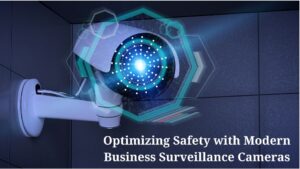
Image Source: Canva
In a business environment, ensuring the safety and security of your premises, employees, and assets is paramount. Modern business surveillance cameras have emerged as a powerful tool in this regard, offering advanced features and capabilities that go far beyond simple video recording. This blog post will explore how to optimize safety using state-of-the-art surveillance systems, covering everything from choosing the right equipment to implementing best practices for maximum effectiveness.
Understanding the Evolution of Surveillance Technology
The journey of surveillance cameras from grainy analog footage to crystal-clear digital video represents a significant leap in both quality and functionality. Early CCTV systems were limited by poor image quality and the need for extensive physical storage. Modern digital systems, however, offer high-definition video, remote accessibility, and integration with other security systems.
Artificial Intelligence (AI) and Machine Learning (ML) have revolutionized the capabilities of surveillance systems. These technologies enable cameras to not just record but to analyze and interpret visual data in real-time. From facial recognition to anomaly detection, AI-powered cameras are transforming passive monitoring into proactive security management.
Key Features of Modern Business Surveillance Cameras
Today’s business surveillance cameras offer resolutions up to 4K and beyond, ensuring that every detail is captured with clarity. This high level of detail is crucial for identifying individuals, reading license plates, and providing admissible evidence in legal proceedings.
Modern business surveillance cameras also feature WDR technology, allowing them to produce clear images in challenging lighting conditions, such as entrances where bright outdoor light contrasts with darker indoor areas. This ensures consistent image quality throughout the day and night. Advanced infrared (IR) technology enables these cameras to capture clear footage even in complete darkness.
Some models offer color night vision, providing more detailed and natural-looking nocturnal imagery. Additionally, panoramic business surveillance cameras can provide a full 360-degree view of an area, eliminating blind spots and reducing the number of cameras needed to cover a space effectively.
Intelligent Video Analytics: The Game Changer
Modern systems can detect and track movement across multiple cameras, alerting security personnel to potential threats and providing a comprehensive view of an individual’s path through a facility. While controversial, facial recognition technology can significantly enhance security by identifying known individuals, whether they’re employees, VIPs, or persons of interest.
AI-powered cameras can identify and classify objects, from abandoned bags to weapons, triggering alerts based on predefined rules. Advanced systems can recognize unusual behavior patterns, such as loitering, aggressive movements, or falls, enabling rapid response to potential security or safety incidents.
Integrating Surveillance with Other Security Systems
By linking surveillance cameras with access control systems, businesses can correlate visual data with entry and exit events, enhancing overall security and streamlining investigations.
Integration with alarm systems allows cameras to automatically focus on areas where alarms have been triggered, providing immediate visual verification of potential threats. Modern surveillance systems often come with comprehensive management software that allows for centralized control, monitoring, and analysis of multiple cameras and security devices across different locations.
Implementing Best Practices for Surveillance System Deployment
Before installing cameras, conduct a comprehensive assessment of your premises to identify vulnerable areas, potential blind spots, and optimal camera placement locations.
Strategic camera placement is crucial for maximizing coverage and deterring potential criminal activity. Consider factors such as lighting, obstructions, and areas of high traffic or value.
While many modern cameras perform well in low-light conditions, proper lighting enhances the quality of surveillance footage and acts as a deterrent to criminal activity. Establish a routine maintenance schedule to ensure all cameras and related equipment are functioning correctly. Regularly update software and firmware to address security vulnerabilities and access new features.
Addressing Privacy Concerns and Legal Compliance
Familiarize yourself with local, state, and federal laws regarding surveillance and privacy. This includes regulations on where cameras can be placed and how footage can be used. Use features like privacy masking to block out areas where surveillance is not permitted or necessary, such as changing rooms or neighboring properties.
Create and communicate clear policies regarding the use of surveillance systems, including who has access to footage, how long it’s retained, and under what circumstances it can be reviewed or shared.
Leveraging Cloud Technology for Enhanced Security
Cloud-based storage solutions offer secure, off-site backup of surveillance footage, protecting against data loss due to on-site equipment failure or tampering.
Cloud-connected systems allow authorized personnel to view live feeds and recorded footage from anywhere, enhancing real-time response capabilities and facilitating remote management. Cloud-based surveillance solutions offer easy scalability, allowing businesses to add cameras and storage capacity as needed without significant infrastructure investments.
Training and Awareness: Maximizing the Human Element
Invest in comprehensive training for security personnel and other employees who will be operating or monitoring the surveillance system. This ensures that the technology is used effectively and appropriately.
Educate all employees about the presence and purpose of surveillance systems. This not only enhances the deterrent effect but also helps in creating a culture of security awareness.
Develop and regularly practice incident response protocols that incorporate surveillance system capabilities, ensuring swift and effective action in the event of a security breach or safety incident.
Use data from security incidents to refine and improve your surveillance strategy, adjust camera placements, update analytics rules, or enhance integration with other systems as needed. Keep abreast of new developments in surveillance technology and consider how emerging features and capabilities could enhance your security posture.
Frequently Asked Questions
1. Are modern surveillance cameras difficult to install and maintain?
While professional installation is recommended for optimal performance, many modern systems are designed for easy setup and maintenance, with user-friendly interfaces and remote management capabilities.
2. Can surveillance cameras prevent crime?
While cameras alone can’t prevent all crime, they serve as a significant deterrent and can greatly assist in quick response and investigation of incidents.
3. How long should we retain surveillance footage?
Retention periods vary based on legal requirements and business needs but typically range from 30 to 90 days. Consult local regulations and your security policy to determine the appropriate duration.
4. Are there privacy concerns with using AI-powered surveillance cameras?
Yes, there are privacy considerations. It’s crucial to implement clear policies, obtain necessary consent, and comply with all relevant privacy laws and regulations.
5. Can our existing analog CCTV system be upgraded to a modern digital system?
In many cases, yes. Many modern systems offer hybrid solutions that can incorporate existing analog cameras while adding new digital capabilities.
Conclusion
Optimizing safety with modern business surveillance cameras requires a holistic approach that goes beyond simply installing high-tech equipment. It involves careful planning, strategic implementation, ongoing management, and a commitment to balancing security needs with privacy concerns.
By leveraging the advanced features of modern surveillance systems, integrating them with other security measures, and fostering a culture of security awareness, businesses can create a robust safety infrastructure that protects assets, deters criminal activity, and provides peace of mind to employees and customers alike.
As technology continues to evolve, the potential for surveillance systems to contribute to business safety will only grow. By staying informed, adaptable, and proactive in their approach to security, businesses can ensure they’re making the most of these powerful tools to create safer, more secure environments for all stakeholders.





